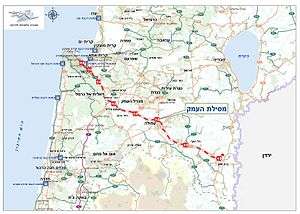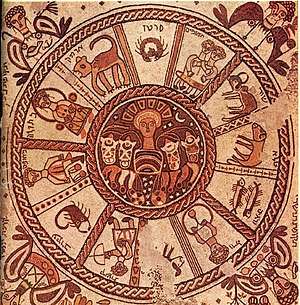Jezreel Valley
The Jezreel Valley is an extensive inland valley large valley, largely rural, located in northern Israel.
Cities and villages

- 🌍 Afula – Not very interesting in and of itself, but it is the largest modern settlement in the Jezreel Valley (current population 45,000).
- 🌍 Kibbutz Geva – one of the original kibbutzim still not privatized, this kibbutz founded by settlers from Poland and Russia is popular among travellers for short and long-term volunteering
- Kiryat Tiv'on – a town on the northwestern border of the region
- Yokne'am Illit – south of Kiryat Tiv'on and on the way into the Carmel Range
Other destinations
- Nahalal – one of the oldest moshavim of Israel and popular for its specific layout (to give all inhabitants an equally sized part of land, a community building was built in the middle and around it the land was split up like a round cake)
Understand
The Jezreel Valley lies between the Carmel Range and the coastal plain to the west and Beit She'an Valley to the east. It stretches from the mountains of the Lower Galilee in the north to the Shomron mountains in the south.
The Jezreel Valley is the only place where the Holy Land can be crossed without travelling through mountainous areas. As a result, in ancient times the Jezreel Valley was an important trade route, and various important battles between Middle Eastern powers took place in this region. One of the most important battles occurring here was the Battle of Ain Jalut (1260), held where the modern village of Ein Harod is located, in which the Muslim Mamluk forces defeated the forces of the Mongol Empire, and stopped them from advancing further westward.
The Christian "Armageddon" refers to the city of Meggido in the valley. According to the New Testament (Book of Revelation), a great battle will be held in the future at the Jezreel Valley between a number of armies that will result in the end of the world.
Get in

By bus
There are several bus lines that pass through the Jezreel Valley, originating from Haifa and Tel Aviv, all passing through the central bus station in Afula, and many of them continue northwards to Tiberias and various other cities in the Lower Galilee and Upper Galilee. Local buses to smaller towns, villages, or sites can be very infrequent, so check the schedule in advance online or at the Afula central bus station information centre.
By train
The Jezreel Valley railway line runs the length of the valley, from Haifa to Beit Shean with stops in Yokneam-Kfar Yehoshua, Migdal Haemek-Kfar Baruch, and Afula. Trains are hourly. Unfortunately, the stops tend to be in remote locations outside cities. The Jezreel Valley line had been abandoned in the 1940s only to be rebuilt in the 2010s as part of a major resurgence of rail transport in Israel. While the old line was built to a narrow gauge, the new line is standard gauge.
Get around
The main roads in the Jezreel Valley go through Afula, so you will probably have to go there.
See
.jpg)
- 🌍
Tel Megiddo & National Park (Armageddon) (Tel Megiddo National Park is on Route 66 between Megiddo Junction and Yokne'am Junction, about 2 km northwest of Megiddo junction. Kibbutz Megiddo lies nearby. Several buses stop at the Megiddo Junction, most notably the 825 between Tel Aviv and Afula. From here, you can walk to Tel Megiddo either along the western side of the road or through the Kibbutz. (There is a path east of the road, too - with a beautiful view towards the tel - if you are really into it.) More comfortably, you can try to flag down a taxi or hitchhike for these 2 km, or wait for a bus from Afula (approximately hourly) which will take you right up to the tel.), ☎ +972 6-652-2167. Apr-Sept 8am-5pm, Oct-Mar 8am-4pm. A Biblical tel with an extensive underground water system, and one of the most important and most impressive destinations for travellers interested in the history and archaeology of the region. It represents a large city mount on the southern edge of the Jezreel Valley and has been the site of several major battles. Megiddo appears on the UNESCO World Heritage list as part of the joint Bibical tels listing, alongside Hazor and Beer Sheva.
The summit of the mount rises to a height of about 60 meters from the plane of the Jezreel valley next to it. The site is strategically located near a main crossroads. Archaeological artifacts indicate that there was a settlement at this site as early as the 4th millennium BC. You can walk through an underground water storage system similar to that in Jerusalem. The site has a good view of the Jezreel Valley's landscape, the Gilboa mountain, the Givat Hamore hill, Mount Tabor and the Nazareth mountain range.
Megiddo is the site of biannual summer excavations conducted by Tel Aviv University and a consortium of overseas institutions - volunteers are welcomed (fees apply for participation and college credit) on each campaign from all over the world. There is a restaurant and several kiosks within the Visitors' Centre. Bring water in summer! The site is low-lying and virtually without shade, so it gets very hot. ₪28/24/14 adult/student/child.

- 🌍 Beth Alpha synagogue, ☎ +972 4-653-2004. Apr-Sept 8am-5pm, Oct-Mar 8am-4pm. An archaeological site containing the remains of a 6th century synagogue located in Kibbutz Beit Alfa, at the northern slopes of Mount Gilboa. The site was discovered in 1928 during the excavation of a water canal to the nearby Kibbutz Hephzibah. ₪22/9 adult/child.
- 🌍 Harod Spring National Park (Ma'ayan Harod), ☎ +972 4-6532211. A recreational park near Mt. Gilboa from which Harod Spring floats from a cave into a stream. The spring's Arabic name is Ain Jalut, and it was near this spring that in 1260 the Mameluk army defeated the Mongols, the first defeat ever suffered by the vast Mongol empire.
- 🌍 Haim Atar Museum of Art, ☎ +972 4-648-5701. An Israeli art museum founded in 1937 located at kibbutz Ein Harod Ihud.
- 🌍 Museum of Pioneer Settlement (Valley Museum). This museum in Kibbutz Yifat presents the story of the kibbutzim in the Jezreel Valley. This may be the best place to learn about the kibbutz, Israel's unique form of collective living.
- 🌍 Palmach Cave (Kibbutz Mishmar Ha'Emek), ☎ +972 4 989-8946. A cave used in the 1940s to train the elite Palmach militia which would become the core of the new Israeli army. There are organized tours.
Do
The valley is pretty quiet. Most dos are in and around Afula, and generally driving from one sight to the other.
Sleep
Try the big reservation websites or Afula.
Go next
- Nazareth in the Lower Galilee – The largest Arab city in Israel and best known as the home of Joseph and Mary.
- Carmel Range, Sea of Galilee region and Golan Heights are close-by and worth a visit.
- Tiberias – A large Israeli town northeast and great starting point for Galilee and Golan.
- Caesarea – Archaeological site, formerly one of the largest ports in the eastern Mediterranean.
- Jenin in the West Bank – Its name's meaning is The spring of gardens. And further south, Nablus, one of the oldest cities in the world and famous for its kunafa/kenafeh.